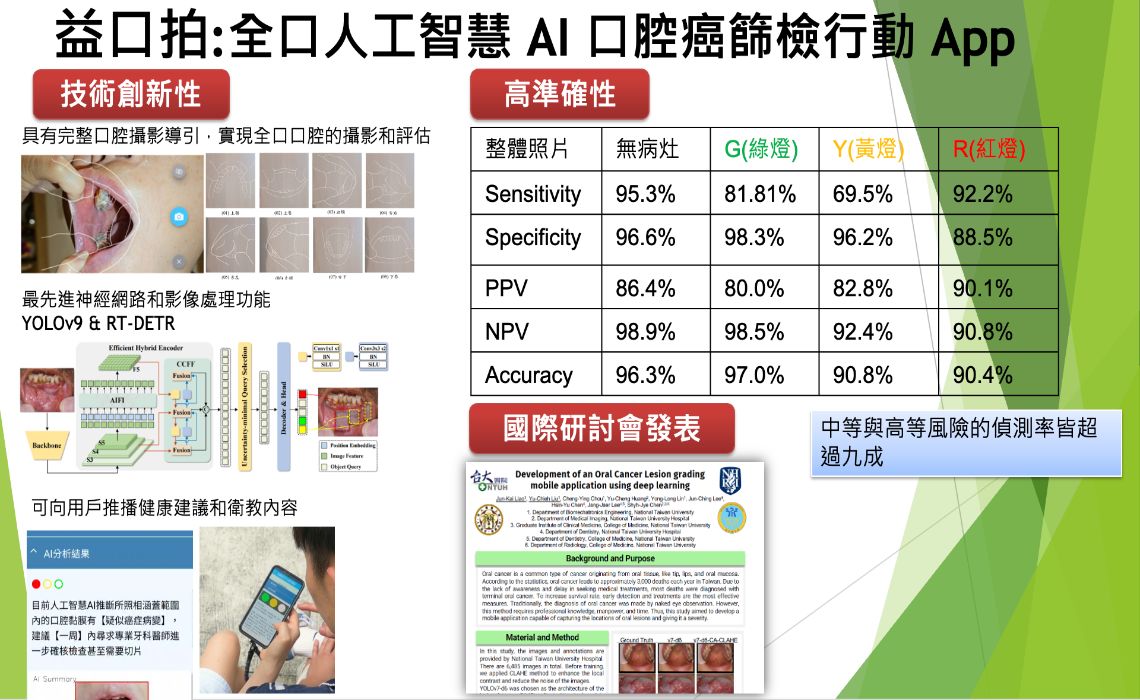

-
 雙型態呈色酵素報告基因系統Dual-structural chromogenic enzyme reporter gene system高雄醫學大學學士後醫學系Post Baccalaureate Medicine, Kaohsiung Medical University林文瑋Wen-Wei Lin發明人:林文瑋、李佳怡、張慕申、劉恩碩、鄭添祿領域:試劑耗材、啟動子活性偵測適應症:無研發階段:已完成概念驗證,待條件優化即可商化。摘要:(Why do?) 現今的報告基因以高敏感度的「雙冷光素酶報告試驗(Dual luciferase reporter assays)」最為廣泛並被大眾所接受,該試驗包含兩不同物種之冷光素酶(東方螢火蟲(Eastern firefly/Photinus pyralis)與海腎(Renilla/Renilla reniformis)。然而,其仍有一些問題需改善:(1)其受質是螢火蟲冷光素(firefly luciferin)與腔腸素(coelenterazine),兩者化學合成皆須使用貴金屬而導致價格昂貴,在反覆進行高通量篩選等大量實驗時,其成本成為一大問題、(2) Luciferase表現於在細胞內,故受質需先通過或是打破細胞膜,酵素與受質兩者接觸後才可被催化、(3) Luciferase的半衰期短且luciferin/coelenterazine化性不夠穩定,若實驗室長期皆需進行藥物或化合物的篩選,酵素及受質不穩定將增加後期實驗結果分析的變異度、(4)偵測訊號之冷光儀不易取得。以上的限制導致此報告基因系統無法於高通量篩選平台中進行實驗。(Aim?) 因此,我們開發出一個半衰期長、成本低廉、操作方便及反應效率高的篩藥報告基因系統。(How do?) 透過呈色酵素(1)表現到細胞膜上形成膜表現呈色酵素(membrane-tethered chromogenic enzyme, MTCE)作為報告者(2)將呈色酵素以基因工程之方式分泌至細胞外(secreted chromogenic enzyme , SCE),兩者合併成為雙型態呈色酵素(dual-structured chromogenic enzyme, DSCE)具有以下優點:(1) 受質便宜,可降低成本、(2) 表現在細胞膜或分泌至細胞外,使受質與酵素直接作用、(3)使膜上MTCE與分泌型SCE一方作為報告基因、另一方作為內部控制組(internal control),控制每次實驗皆具有相同之轉染效率(4)訊號半衰期長且穩定性高、(5)偵測之儀器_ELISA reader易取得。(Conclusion)因此,本技術是第一個將膜表現呈色酵素和篩藥報告基因系統結合,搭配分泌型呈色酵素,使其具有高敏感度、成本低廉、操作方便、半衰期長等優勢,以造福使用者大幅降低高通量藥物篩選時之成本並提高藥物開發效率。
雙型態呈色酵素報告基因系統Dual-structural chromogenic enzyme reporter gene system高雄醫學大學學士後醫學系Post Baccalaureate Medicine, Kaohsiung Medical University林文瑋Wen-Wei Lin發明人:林文瑋、李佳怡、張慕申、劉恩碩、鄭添祿領域:試劑耗材、啟動子活性偵測適應症:無研發階段:已完成概念驗證,待條件優化即可商化。摘要:(Why do?) 現今的報告基因以高敏感度的「雙冷光素酶報告試驗(Dual luciferase reporter assays)」最為廣泛並被大眾所接受,該試驗包含兩不同物種之冷光素酶(東方螢火蟲(Eastern firefly/Photinus pyralis)與海腎(Renilla/Renilla reniformis)。然而,其仍有一些問題需改善:(1)其受質是螢火蟲冷光素(firefly luciferin)與腔腸素(coelenterazine),兩者化學合成皆須使用貴金屬而導致價格昂貴,在反覆進行高通量篩選等大量實驗時,其成本成為一大問題、(2) Luciferase表現於在細胞內,故受質需先通過或是打破細胞膜,酵素與受質兩者接觸後才可被催化、(3) Luciferase的半衰期短且luciferin/coelenterazine化性不夠穩定,若實驗室長期皆需進行藥物或化合物的篩選,酵素及受質不穩定將增加後期實驗結果分析的變異度、(4)偵測訊號之冷光儀不易取得。以上的限制導致此報告基因系統無法於高通量篩選平台中進行實驗。(Aim?) 因此,我們開發出一個半衰期長、成本低廉、操作方便及反應效率高的篩藥報告基因系統。(How do?) 透過呈色酵素(1)表現到細胞膜上形成膜表現呈色酵素(membrane-tethered chromogenic enzyme, MTCE)作為報告者(2)將呈色酵素以基因工程之方式分泌至細胞外(secreted chromogenic enzyme , SCE),兩者合併成為雙型態呈色酵素(dual-structured chromogenic enzyme, DSCE)具有以下優點:(1) 受質便宜,可降低成本、(2) 表現在細胞膜或分泌至細胞外,使受質與酵素直接作用、(3)使膜上MTCE與分泌型SCE一方作為報告基因、另一方作為內部控制組(internal control),控制每次實驗皆具有相同之轉染效率(4)訊號半衰期長且穩定性高、(5)偵測之儀器_ELISA reader易取得。(Conclusion)因此,本技術是第一個將膜表現呈色酵素和篩藥報告基因系統結合,搭配分泌型呈色酵素,使其具有高敏感度、成本低廉、操作方便、半衰期長等優勢,以造福使用者大幅降低高通量藥物篩選時之成本並提高藥物開發效率。
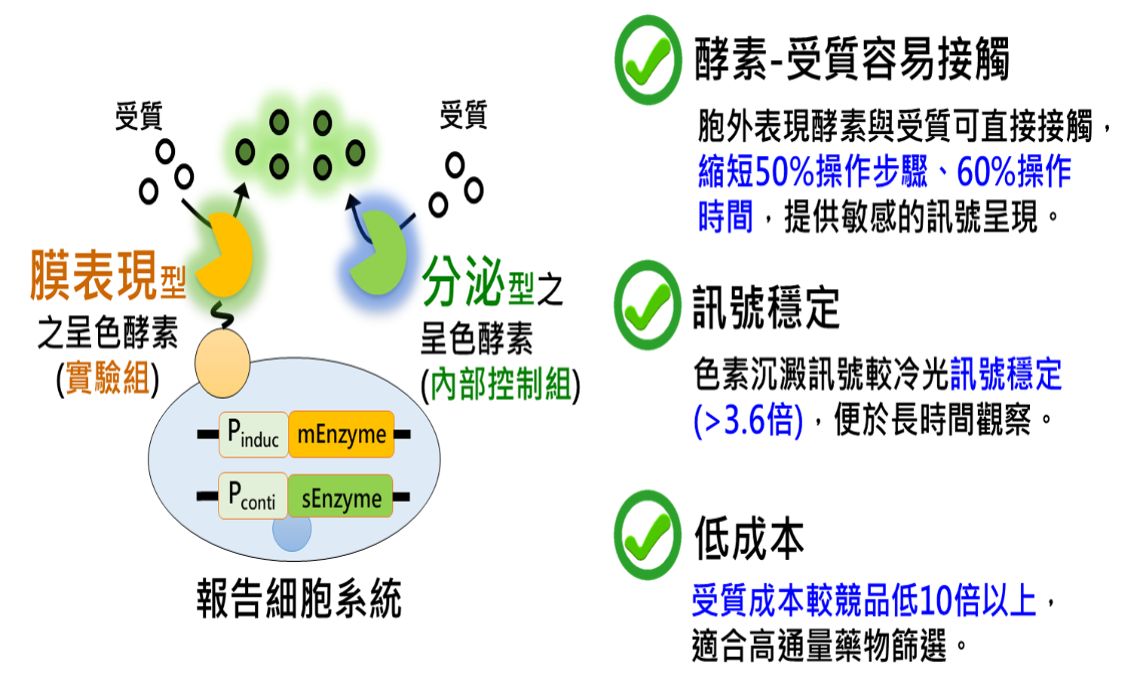
 新型在地開發的自駕單噴流 3D 電紡絲平台,用於重建手術中的金屬植入物塗層及傷口癒合和皮膚再生的替代載體Novel In-house Developed Autopilot Single Jet 3D Electrospinning Platform for Metal Implant Coating in Reconstructive Surgeries and Dermal Substitutes for Wound Healing and Skin Regeneration中央研究院Academia Sinica周家復Chia-Fu Chou發明人:Chia-Fu Chou and Balchandar Navaneethan領域:組織工程、再生醫學適應症:Metal implant coating & wound healing/skin regeneration研發階段:醫材雛型試製造 prototype摘要:我們最近報導了一種新穎的自駕單噴流 3D 電紡絲工藝,其中聚己內酯(PCL) 聚合物噴嘴由從尖端到收集器的電場線自引導,採用獨特的彎曲路徑,導致透過纖維的保形沉積以高解析度複製模板特徵。此為首次使用電紡絲技術建造 3D 支架。這些結構由 FDA 批准的 PCL 聚合物製成,具有細胞可滲透的梯度孔隙率。 自駕單噴流 3D 電紡絲獨特的結構製程也使其具有較高的機械穩健性,並與外科手術相容。第一臨床適應症: 我們與臨床專家合作,應用於由高雄榮民總醫院口腔顎面外科和工業技術研究院南院區共同開發的3D列印鈦基下顎骨, 採用PCL 纖維的金屬植入物塗層,預計可以克服軟組織整合到金屬表面上的挑戰,並解決植入物與周圍軟組織間力學結構不匹配導致的嚴重併發症而導致植入物失敗的問題。第二臨床適應症: PCL 支架可製成有孔手術網,在我們以膠原蛋白浸漬支架後可用於傷口癒合和皮膚再生。
新型在地開發的自駕單噴流 3D 電紡絲平台,用於重建手術中的金屬植入物塗層及傷口癒合和皮膚再生的替代載體Novel In-house Developed Autopilot Single Jet 3D Electrospinning Platform for Metal Implant Coating in Reconstructive Surgeries and Dermal Substitutes for Wound Healing and Skin Regeneration中央研究院Academia Sinica周家復Chia-Fu Chou發明人:Chia-Fu Chou and Balchandar Navaneethan領域:組織工程、再生醫學適應症:Metal implant coating & wound healing/skin regeneration研發階段:醫材雛型試製造 prototype摘要:我們最近報導了一種新穎的自駕單噴流 3D 電紡絲工藝,其中聚己內酯(PCL) 聚合物噴嘴由從尖端到收集器的電場線自引導,採用獨特的彎曲路徑,導致透過纖維的保形沉積以高解析度複製模板特徵。此為首次使用電紡絲技術建造 3D 支架。這些結構由 FDA 批准的 PCL 聚合物製成,具有細胞可滲透的梯度孔隙率。 自駕單噴流 3D 電紡絲獨特的結構製程也使其具有較高的機械穩健性,並與外科手術相容。第一臨床適應症: 我們與臨床專家合作,應用於由高雄榮民總醫院口腔顎面外科和工業技術研究院南院區共同開發的3D列印鈦基下顎骨, 採用PCL 纖維的金屬植入物塗層,預計可以克服軟組織整合到金屬表面上的挑戰,並解決植入物與周圍軟組織間力學結構不匹配導致的嚴重併發症而導致植入物失敗的問題。第二臨床適應症: PCL 支架可製成有孔手術網,在我們以膠原蛋白浸漬支架後可用於傷口癒合和皮膚再生。
技術獲得專利: 美國、中華民國(歐盟及中國專利審查中)
技術獲得獎項: 2023 國家新創獎; 2024 未來科技獎
We have recently reported a novel Autopilot Single-Jet (AJ) 3D Electrospinning (ES) process, in which a polycaprolactone (PCL) polymer jet, self-guided by the field lines from the tip to the collector, takes unique bending paths, leading to high-resolution replication of template features with conformal deposition of fibers. This also marks first-ever 3D scaffolds construction using electrospinning technique. Made from FDA-approved PCL polymer, these constructs characterized for their cell-permeable gradient porosity. The unique construction process of AJ-3D ES also contributed to its high mechanical robustness, compatible with surgical procedures. First clinical indication: we collaborate with clinical experts to apply on 3D printed titanium-based mandible bone co-developed by Maxillofacial Department of Kaohsiung Veterans General Hospital (KSVGH) & Industrial Technology Research Institute (ITRI) Southern Campus, for metal implant coating with PCL fibers that is anticipated to overcome the soft tissue integration onto the metal surface to avoid severe complications from mechanical mismatch between the implant and surrounding soft tissues, and the associated implant failure. Second clinical indication: The PCL scaffolds, which can be made into fenestrated surgical mesh, is identified for wound healing and skin regeneration up on impregnation with collagen.
Patents granted: USA and ROC (EU and China patents pending)
Awards: 2023 National Innovation Award; 2024 Future Tech Award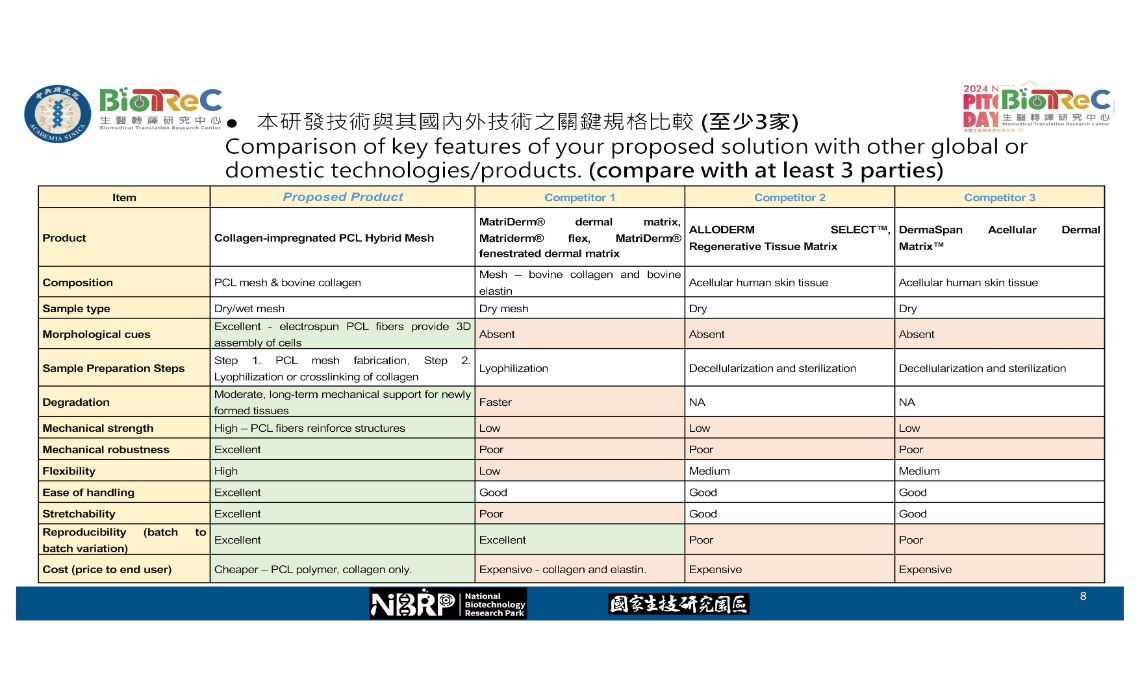
 可量化單一囊胚氧氣消耗率之免標定式胚胎品質檢測晶片Label-free Embryo Quality Detection Chip for Quantifying The Oxygen Consumption Rate of Single Blastocyst國立中興大學/中山醫學大學National Chung Hsing University/Chung Shan Medical University吳靖宙Ching-Chou Wu發明人:李茂盛、吳靖宙、楊秉豐、李嘉恩、鄭恩惠、林羿萍、蔡漢霓、李宗賢、李俊逸領域:生殖醫學、電化學感測晶片適應症:量測單一胚胎之代謝活性研發階段:動物實驗/臨床樣本摘要:Due to the increasing rates of infertility caused by late marriages, work, and environmental stress, the proportion of in vitro fertilization (IVF) in reproductive medicine continues to rise. Currently, there are clinical products for sperm selection. However, the development of fertilized eggs still relies on embryologists' morphological classification, and no in vitro diagnostic (IVD) devices are developed for quantifying embryo quality.
可量化單一囊胚氧氣消耗率之免標定式胚胎品質檢測晶片Label-free Embryo Quality Detection Chip for Quantifying The Oxygen Consumption Rate of Single Blastocyst國立中興大學/中山醫學大學National Chung Hsing University/Chung Shan Medical University吳靖宙Ching-Chou Wu發明人:李茂盛、吳靖宙、楊秉豐、李嘉恩、鄭恩惠、林羿萍、蔡漢霓、李宗賢、李俊逸領域:生殖醫學、電化學感測晶片適應症:量測單一胚胎之代謝活性研發階段:動物實驗/臨床樣本摘要:Due to the increasing rates of infertility caused by late marriages, work, and environmental stress, the proportion of in vitro fertilization (IVF) in reproductive medicine continues to rise. Currently, there are clinical products for sperm selection. However, the development of fertilized eggs still relies on embryologists' morphological classification, and no in vitro diagnostic (IVD) devices are developed for quantifying embryo quality.
Although clinically, preimplantation genetic testing for aneuploidy and mitochondrial copy number testing techniques are available to evaluate embryo functions by obtaining several cells from a single embryo, these techniques have only increased the IVF pregnancy ratio to ~60%. Additionally, these processes require delicate microsurgery and skilled embryologists, making the technical fees in IVF procedures expensive and time-consuming. For example, at Lee Women’s Reproductive Medicine Center, technical fees often occupy 40-50% of the total cost. Reducing the manual operation fees of embryologists is a significant clinical economic issue.
Currently, the label-free and non-invasive clinical equipment for embryo quality testing is the Vitrolife time-lapse embryo incubator (priced at approximately 12 million NTD), which uses AI image analysis and real-time image recording systems to determine morphological classifications automatically. The current charge is 12,000 NTD for placing 16 embryos in the incubator for five days, but it only increases the implantation ratio to ~67% after embryo selection. This indicates a clinical need for embryo quality testing in the market. However, image analysis cannot determine the actual embryo developmental function. Therefore, developing testing techniques that can quantify the mitochondrial function of embryos has clinical significance and medical value for preimplantation embryo selection.
Currently, no commercial IVD device exists for blastocyst quality testing. The main reasons include the need to consider cell safety, reproductive toxicity, clinical efficacy, and ease of operation by embryologists during the testing process and equipment use. Although several teams, such as Tohoku University in Japan (Patent No. JP2010-121948A), Panasonic Intellectual Property Management Co., Ltd. (Patent No. US10458941B2), and Chongqing Medical University (Application No. CN117030824A), have proposed using electrochemical array electrodes and microporous structures to measure the oxygen consumption rate (OCR) of embryos as an indicator for blastocyst respiratory function testing.
However, these patents or related academic papers mainly integrate platinum reference and working electrodes on the same substrate. They etched a continuous-wall microhole of a single thickness in the electrodes' substrate to fix a single embryo. Due to the size variation between different embryos, the microhole diameter is much larger than the embryos, and the embryos are positioned below the electrode substrate. This setup hinders establishing and calculating the diffusion layer generated by embryo oxygen consumption. Additionally, the small and continuous-wall microhole structure poses operational challenges for embryologists, as the fluid injected with a pipette can easily push the embryos away from the microhole. This requires precise microscopic manipulation to position the embryo near the microhole, allowing it to fall into the microholes.
Furthermore, most current electrochemical embryo OCR measurement chips use platinum pseudo-reference electrodes with unstable potentials. Protein contamination in cell culture media can cause significant reference potential shifts, resulting in inaccurate electrochemical OCR measurements. Using external Ag/AgCl electrodes fails to meet the requirements for sterility and disposability.
1. Our technique uses microfabrication technology to create a multi-layer concentric staircase structure on a substrate to fix embryos. The inner diameter of the top layer structure is much larger than the embryo diameter, facilitating manual droplet position control by embryologists. The multi-layer staircase design allows embryos to settle naturally at the bottom center of the structure due to gravity, positioning the embryo at a precise distance from the electrode array. The discontinuous wall staircase structure helps quickly dissipate turbulence caused by pipette injection, minimizing its impact on embryo settlement.
2. This technique employs a solid-state salt bridge on the chip to connect the reference-electrode container and the working-electrode container. The chip-based Ag/AgCl electrode quickly provides a stable reference potential after electrolyte injection, stabilizing OCR measurements. Additionally, the chip-based Ag/AgCl reference electrode is available for dry storage and sterilization, supporting the disposable needs of the overall chip after measuring embryos obtained from the same mother.
3. Previous studies conducted embryo development in a 20% O2 incubator and performed OCR measurements under the same oxygen concentration. However, IVF now commonly occurs in a 5% O2 environment to reduce oxidative stress on embryos. This chip has validated that blastocysts moved from a 5% O2 incubator can reach maximum OCR within 15 minutes. This chip measured OCR values and morphological quality classifications of 17 blastocyst-stage mouse embryos, showing a high positive correlation between the two. Moreover, good and average blastocysts can be distinguished with 100% sensitivity through ROC curve analysis. When standardizing OCR by embryo radius (rs), an OCR/rs more significant than 2 fmol/s*μm significantly distinguishes good-quality embryos from fair or poor-quality ones, with good-quality embryos having a hatching rate of over 90%. These results indicate that this chip design can quantify embryo quality.
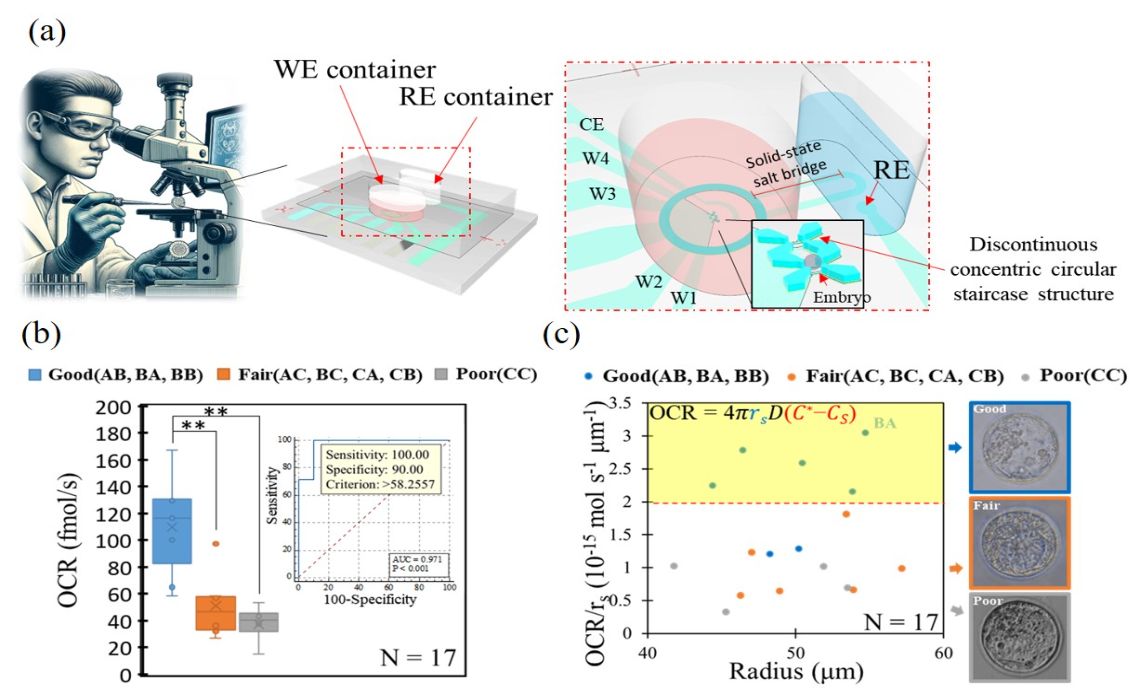
 生成式人工智慧個人化4D高齡健康失智預測模組Personalized 4D prediction of brain age and dementia using generative AI神瑞人工智慧DeepRad.AI張曜吉Roger Chang發明人:陳震宇/Cheng-Yu Chen領域:智慧醫療、預防醫學適應症:老年痴呆症 Dementia, 腦年齡 Brain Age, 腦健康 Brain Health研發階段:候選藥物/醫材雛型臨床前試驗 Preclinical trials摘要:高齡化社會是個全球的議題與挑戰,失智症的發生率也越來越高,因此發展腦心智退化之早期偵測指標與風險預測模式,為臨床重要而尚未被滿足之需求。本團隊利用大型腦部影像資料庫與條件式自編碼生成對抗網路,打造「生成式人工智慧個人化4D高齡健康失智預測模組」,已獲得2023國家新創獎與2022國科會未來科技突破獎,演算法模組能自動生成報告,不僅能計算腦齡,關鍵創新在於能精準預測未來的失智可能風險和腦皮質萎縮區域樣態,有助臨床診斷,將可為亞健康族群提供未來腦心智老化期程之風險預測,亦有助於及早介入、延緩老化及預防醫學的發展。
生成式人工智慧個人化4D高齡健康失智預測模組Personalized 4D prediction of brain age and dementia using generative AI神瑞人工智慧DeepRad.AI張曜吉Roger Chang發明人:陳震宇/Cheng-Yu Chen領域:智慧醫療、預防醫學適應症:老年痴呆症 Dementia, 腦年齡 Brain Age, 腦健康 Brain Health研發階段:候選藥物/醫材雛型臨床前試驗 Preclinical trials摘要:高齡化社會是個全球的議題與挑戰,失智症的發生率也越來越高,因此發展腦心智退化之早期偵測指標與風險預測模式,為臨床重要而尚未被滿足之需求。本團隊利用大型腦部影像資料庫與條件式自編碼生成對抗網路,打造「生成式人工智慧個人化4D高齡健康失智預測模組」,已獲得2023國家新創獎與2022國科會未來科技突破獎,演算法模組能自動生成報告,不僅能計算腦齡,關鍵創新在於能精準預測未來的失智可能風險和腦皮質萎縮區域樣態,有助臨床診斷,將可為亞健康族群提供未來腦心智老化期程之風險預測,亦有助於及早介入、延緩老化及預防醫學的發展。
"Aging is a global issue and challenge, resulting in increasing incidence of dementia. Hence, there is an urgent need to develop methods for the early detection of dementia risk. Our team utilized several large brain imaging database in combination with CVAE-GAN (Conditional Variational Autoencoder Generative Adversarial Network) to create the ""Personalized 4D prediction of brain age and dementia using generative AI.""
Our technologies have won the 2023 National Innovation Award and the 2022 Future Tech Award from the National Science and Technology Council. Within a few clicks, the platform enables automatically generate structural reports, that includes evaluation of brain age and assessment of the potential risk of dementia over the next two years basing on the pattern of atrophy in the brain cortex areas. This innovation aids in clinical diagnosis and is expected to provide a risk prediction model for cognitive degenerative processes in the sub-healthy population. It also contributes to early intervention, delaying aging, and the development of preventive medicine."
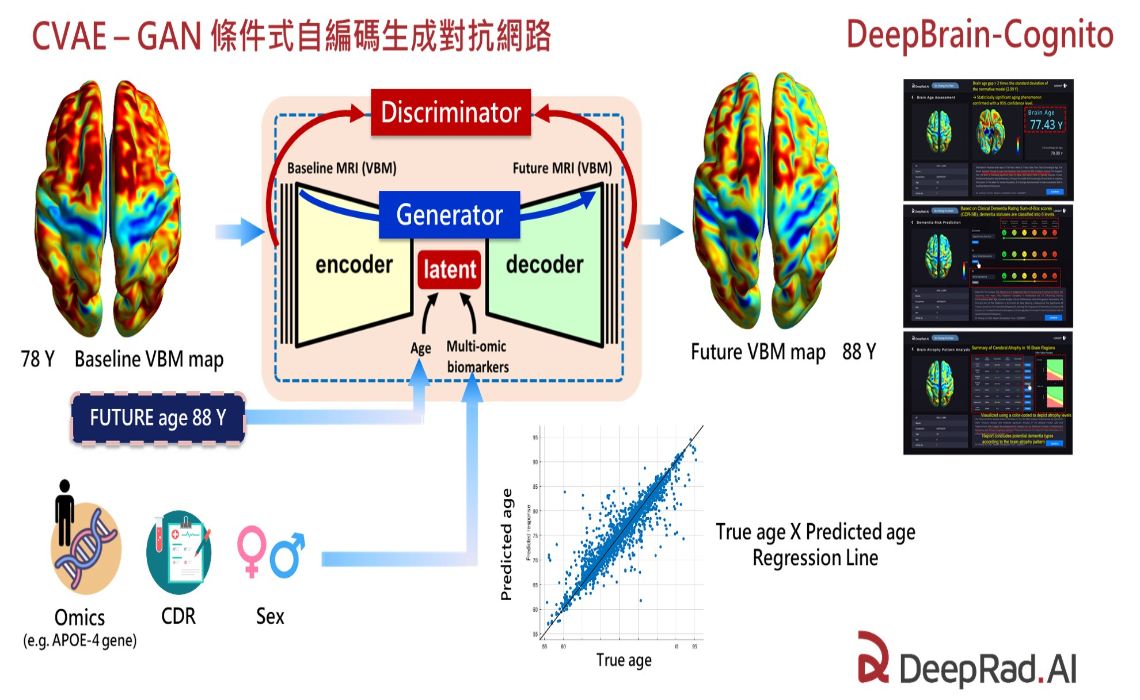
 肺癌智慧多模決策分享系統All-In-One lung cancer decision sharing system- DeepLung CDSS-Bot臺北醫學大學Taipei Medical University陳震宇Cheng-Yu Chen發明人:陳志榮、張資昊、張詠淳領域:醫療保健業適應症:肺癌患者研發階段:團隊運用高品質臨床大數據,發展人工智慧代理人(AI Agent)多模組肺癌臨床智慧決策輔助系統,擁有晚期肺癌最初診斷14天醫病決策分享四個模組機器人,四模組具TRL 7的技術成熟度,已進行臨床場域測試並申請台灣食品藥物管理署專案輔導。預計2025年完成臨床場域驗證摘要:肺癌依細胞型態可分為「小細胞肺癌」與「非小細胞肺癌」兩大類,後者在台灣約佔92%,也是臺灣非抽煙年輕婦女最常罹患的肺癌,其中基因突變又以表皮生長因子受體(EGFR)佔50-60%為大宗,在肺癌的最初診斷中,約有60%患者已進入癌症晚期階段,且晚期肺癌患者五年存活機率僅5.2%,儘管使用標靶藥物及免疫細胞療法,五年存活率仍僅有15%。為提高精準用藥,治療上需先確認癌症生長加速因子,如前述表皮生長因子,再進一步選擇標靶藥物,由於標靶藥物分類與保險給付複雜,醫院流程理想上需經由分子腫瘤討論會決策(molecular tumor board),但是即使醫學中心等級,極少能投入多重專業人力進行高度精準醫療決策,因而可能延遲個案初期診斷治療使用標靶黃金14天的治療時機。根據Guirado等人對於美國、澳洲、日本及英國等共38份文獻分析結果,肺癌病患自首次至醫院就診直到診斷平均需要29.54天。精準早期診斷與用藥是延緩病情惡化的關鍵。
肺癌智慧多模決策分享系統All-In-One lung cancer decision sharing system- DeepLung CDSS-Bot臺北醫學大學Taipei Medical University陳震宇Cheng-Yu Chen發明人:陳志榮、張資昊、張詠淳領域:醫療保健業適應症:肺癌患者研發階段:團隊運用高品質臨床大數據,發展人工智慧代理人(AI Agent)多模組肺癌臨床智慧決策輔助系統,擁有晚期肺癌最初診斷14天醫病決策分享四個模組機器人,四模組具TRL 7的技術成熟度,已進行臨床場域測試並申請台灣食品藥物管理署專案輔導。預計2025年完成臨床場域驗證摘要:肺癌依細胞型態可分為「小細胞肺癌」與「非小細胞肺癌」兩大類,後者在台灣約佔92%,也是臺灣非抽煙年輕婦女最常罹患的肺癌,其中基因突變又以表皮生長因子受體(EGFR)佔50-60%為大宗,在肺癌的最初診斷中,約有60%患者已進入癌症晚期階段,且晚期肺癌患者五年存活機率僅5.2%,儘管使用標靶藥物及免疫細胞療法,五年存活率仍僅有15%。為提高精準用藥,治療上需先確認癌症生長加速因子,如前述表皮生長因子,再進一步選擇標靶藥物,由於標靶藥物分類與保險給付複雜,醫院流程理想上需經由分子腫瘤討論會決策(molecular tumor board),但是即使醫學中心等級,極少能投入多重專業人力進行高度精準醫療決策,因而可能延遲個案初期診斷治療使用標靶黃金14天的治療時機。根據Guirado等人對於美國、澳洲、日本及英國等共38份文獻分析結果,肺癌病患自首次至醫院就診直到診斷平均需要29.54天。精準早期診斷與用藥是延緩病情惡化的關鍵。
本技術使用先進的生成式人工智慧數位代理語言模型,能整合胸部電腦斷層報告、病理報告和次世代基因定序資料,產生回答醫病決策提問的支持建議。
研究團隊曾獲得兩次國科會未來科技獎和三次國家新創獎,且已進行臨床測試,目前已通過4項台灣專利,5項美國/台灣正進行申請及審核,另預計再申請3項專利。本技術將滿足醫療機構癌症精準醫療的決策共享需求,不僅大幅減少醫護人員工作量,並能有效縮短病人診斷時程,提供早期精準用藥決策建議,另也加速大藥廠找尋新藥適當病人和新藥臨床試驗。本團隊技術首創將數位代理技術(Agentic AI)運用於醫療,可引領多種新型智慧醫材開發,促進台灣新創具備國際競爭力。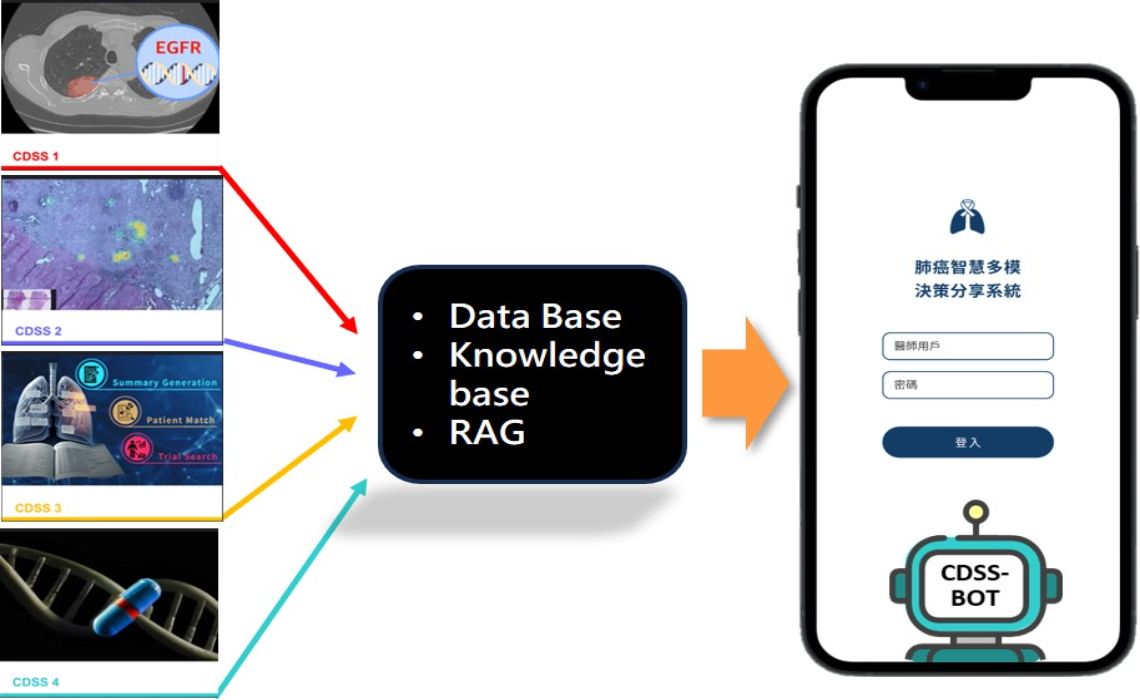
 一種應用偵測胸腹式呼吸型態結合呼吸音分析之多數據生理監測裝置A multi-data physiological monitoring device that detects thoracoabdominal breathing patterns and combines breathing sound analysis台北醫學大學附設醫院事業發展部Department of Business Development, Taipei Medical University Hospital周百謙醫師Dr. Pai-Chien Chou, MD PhD發明人:周百謙、陳建華、莊雅婷領域:生理數據監測與衍生照護適應症:呼吸偏喘,呼吸障礙,血氧濃度不佳原因判斷研發階段:原型品已完成,TFDA醫材徵詢中摘要:呼吸偏喘是許多病患的問題。但受限於現有醫療型態,要找尋呼吸偏喘患者的病因,需透過長時間偵測歸納,推估不正常病況的臨床表現,如此才能在呼吸偏喘時找到問題所在,並進行其他輔助醫療治療。為進行有效呼吸評估,目前臨床均以聽診器搭配理學檢查,確認病患臨床狀況是否穩定。目前醫材設計多僅以呼吸音進行喘鳴聲,以及痰音之評估,做為病態評估。但單純性呼吸音分析很難確定呼吸雜音來自於吸氣期,或吐氣期,同時也無法偵測肺部不同位置的問題,也就不能掌握和呼吸代償失衡的惡化點。生理數據的數位化監測是必要發展,然而目前的監測產品多僅偏重單一化描述呼吸現象,未能了解全貌。因此本計畫提出透過穿戴式裝置整合,結合麥克風、應變器、G sensor等模組,進行呼吸音,胸壁起伏,以及胸腹部的呼吸同步動作分析,後續透過AI algorithm的整合,比對病患不同生理狀況,推估病患臨床穩定程度。藉此設計,可以把呼吸動作分辨為深淺快慢等型式,評估臨床為胸式或腹式呼吸,並分析痰量多少及其他呼吸道問題。更透過創新性 risk score的建立,將使用者生理現象的變化,可以透過 score 的改變建立臨床監測上對於病情評估的依據,同時連結後續的警示與必要治療,在本裝置連續偵測的概念下,細緻化描述病患的呼吸動作,從而定義病患的生理代償是否完備,簡化醫療端的照護複雜度,可望成為現在醫療照護上需要的關鍵設計。
一種應用偵測胸腹式呼吸型態結合呼吸音分析之多數據生理監測裝置A multi-data physiological monitoring device that detects thoracoabdominal breathing patterns and combines breathing sound analysis台北醫學大學附設醫院事業發展部Department of Business Development, Taipei Medical University Hospital周百謙醫師Dr. Pai-Chien Chou, MD PhD發明人:周百謙、陳建華、莊雅婷領域:生理數據監測與衍生照護適應症:呼吸偏喘,呼吸障礙,血氧濃度不佳原因判斷研發階段:原型品已完成,TFDA醫材徵詢中摘要:呼吸偏喘是許多病患的問題。但受限於現有醫療型態,要找尋呼吸偏喘患者的病因,需透過長時間偵測歸納,推估不正常病況的臨床表現,如此才能在呼吸偏喘時找到問題所在,並進行其他輔助醫療治療。為進行有效呼吸評估,目前臨床均以聽診器搭配理學檢查,確認病患臨床狀況是否穩定。目前醫材設計多僅以呼吸音進行喘鳴聲,以及痰音之評估,做為病態評估。但單純性呼吸音分析很難確定呼吸雜音來自於吸氣期,或吐氣期,同時也無法偵測肺部不同位置的問題,也就不能掌握和呼吸代償失衡的惡化點。生理數據的數位化監測是必要發展,然而目前的監測產品多僅偏重單一化描述呼吸現象,未能了解全貌。因此本計畫提出透過穿戴式裝置整合,結合麥克風、應變器、G sensor等模組,進行呼吸音,胸壁起伏,以及胸腹部的呼吸同步動作分析,後續透過AI algorithm的整合,比對病患不同生理狀況,推估病患臨床穩定程度。藉此設計,可以把呼吸動作分辨為深淺快慢等型式,評估臨床為胸式或腹式呼吸,並分析痰量多少及其他呼吸道問題。更透過創新性 risk score的建立,將使用者生理現象的變化,可以透過 score 的改變建立臨床監測上對於病情評估的依據,同時連結後續的警示與必要治療,在本裝置連續偵測的概念下,細緻化描述病患的呼吸動作,從而定義病患的生理代償是否完備,簡化醫療端的照護複雜度,可望成為現在醫療照護上需要的關鍵設計。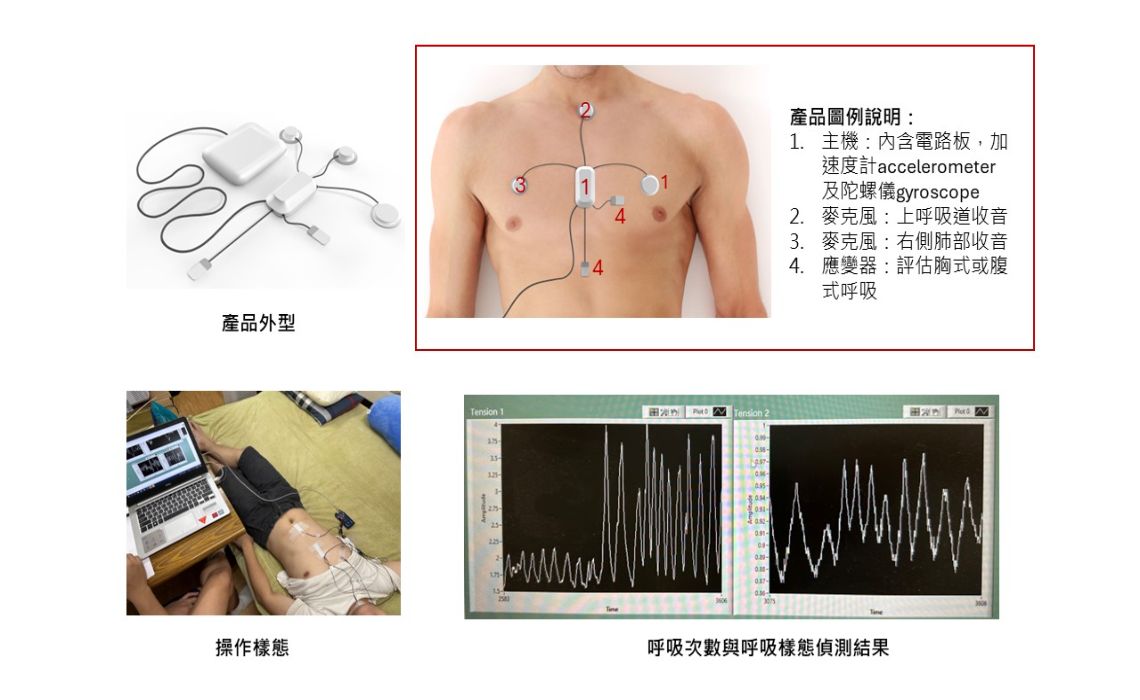
 可注射式及原位成型之抗菌性水膠載體台北醫學大學/ 雙和醫院骨科部黃錦前發明人:黃錦前/莊爾元/陳志華領域:適應症:本水膠用於植入在骨關節空隙之中充當載體, 並以此水膠載體為基礎, 用以製備成攜帶抗生物藥物的含藥醫療器材, 用於骨骼肌肉感染症之治療與預防研發階段:候選藥物/醫材雛型試製造 Pilot production of candidate drug/prototype摘要:在骨科臨床作業中,骨骼肌肉系統感染症的發生不僅大大加重了醫療系統的負荷,且會造成手術死亡率的提升,以及造成延長住院及增加醫療支出等問題。我們開發了以Gelatin, hyaluronic acid以及genipin組合成的溫感性水膠, 透過添加不同濃度的genipin能夠有效地透過材料之交聯作用進而提升材料之機械強度。其材料優勢包括能夠達成所包裹藥物的緩慢釋放以及延長其生物降解之時間。透過實驗確認水膠的最佳配比,並利用溫感性水膠包覆萬古黴素抗生素藥物-水膠系統並對其物理化學性質 (流變學、體外藥物釋放、材料-細胞活性測試,抗菌效力,生物膜模式等) 做有效之分析探討。爾後, 則是進一步透過將材料植入小鼠及兔子動物模式進行活體內材料生物相容性, 降解性及藥物動力學分析。
可注射式及原位成型之抗菌性水膠載體台北醫學大學/ 雙和醫院骨科部黃錦前發明人:黃錦前/莊爾元/陳志華領域:適應症:本水膠用於植入在骨關節空隙之中充當載體, 並以此水膠載體為基礎, 用以製備成攜帶抗生物藥物的含藥醫療器材, 用於骨骼肌肉感染症之治療與預防研發階段:候選藥物/醫材雛型試製造 Pilot production of candidate drug/prototype摘要:在骨科臨床作業中,骨骼肌肉系統感染症的發生不僅大大加重了醫療系統的負荷,且會造成手術死亡率的提升,以及造成延長住院及增加醫療支出等問題。我們開發了以Gelatin, hyaluronic acid以及genipin組合成的溫感性水膠, 透過添加不同濃度的genipin能夠有效地透過材料之交聯作用進而提升材料之機械強度。其材料優勢包括能夠達成所包裹藥物的緩慢釋放以及延長其生物降解之時間。透過實驗確認水膠的最佳配比,並利用溫感性水膠包覆萬古黴素抗生素藥物-水膠系統並對其物理化學性質 (流變學、體外藥物釋放、材料-細胞活性測試,抗菌效力,生物膜模式等) 做有效之分析探討。爾後, 則是進一步透過將材料植入小鼠及兔子動物模式進行活體內材料生物相容性, 降解性及藥物動力學分析。
n orthopedic practices, these serious infections place a marked burden onto systems of healthcare, resulting in high surgical mortality, prolonged hospitalization, and increased medical expenses. In situ forming thermosensitive hydrogels have been studied extensively as a platform for tropical drug delivering system. In this study, we aim for evaluating the potential antimicrobial role of antibiotic-loaded hydrogel through incorporating vancomycin into a biodegradable, biocompatible and thermosensitive hydrogel composed of gelatin, hyaluronic acid and genipin. The addition of genipin would reinforce the mechanical strength of hydrogel through chemical cross-linking, thus forming a barrier for the acute burst releasing of the embedded antibiotics.In this project, a vancomycin-loaded hydrogel releasing platform would be fabricated in different formulations and their physiochemical properties, biocompatibility, encapsulation efficiency, in vitro drug release kinetics, and antimicrobial efficacy on biofilm formation would be carefully studied. Finally, the genipin-crosslinked gelatin/hyaluronic acid containing antibiotics would be implanted in murine and rabbit animal models.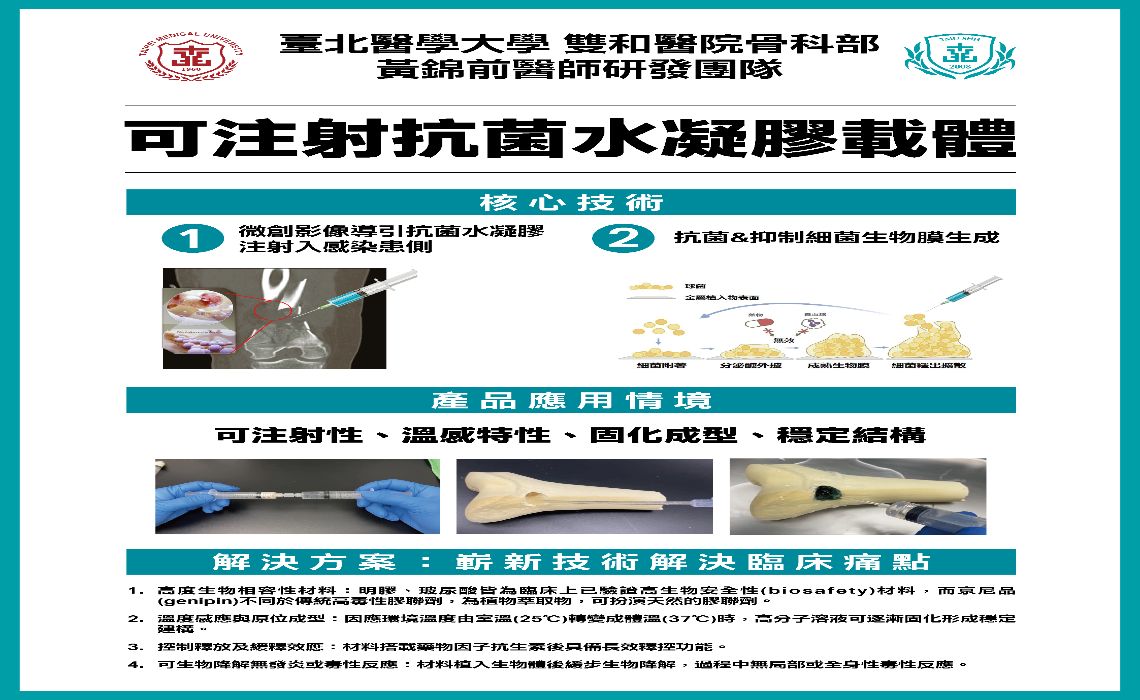
 VR智慧針灸教學及臨床模擬系統VR Intelligent Acupuncture Teaching and Clinical Simulation System中國醫藥大學China Medical University黃升騰Sheng-Teng Huang發明人:洪明奇、林昭庚、葛介正、黃維德、歐世宸領域:VR智慧針灸教學及臨床模擬系統適應症:針灸教育與臨床應用研發階段:虛擬實境針灸系統開發與更新摘要:穴位針灸是中華民族古老的治療技術,不管在現代醫學領域,針灸都有它一定的療效,且陸續有權威國際期刊證實其有效性。然而,針灸的學習、實作和臨床模擬過去皆以紙本、圖片為主,故在實際接觸到病人前,真正有進行針刺的經驗少之又少,很多醫師都是到了臨床時,才在患者身上練習,這造成了病安和療效上的疑慮。目前有許多的APP軟體可以給予穴位的知識及位置,但也僅局限於圖片或者3D解剖圖,對於實際操作來說也是一個很大的缺口。
VR智慧針灸教學及臨床模擬系統VR Intelligent Acupuncture Teaching and Clinical Simulation System中國醫藥大學China Medical University黃升騰Sheng-Teng Huang發明人:洪明奇、林昭庚、葛介正、黃維德、歐世宸領域:VR智慧針灸教學及臨床模擬系統適應症:針灸教育與臨床應用研發階段:虛擬實境針灸系統開發與更新摘要:穴位針灸是中華民族古老的治療技術,不管在現代醫學領域,針灸都有它一定的療效,且陸續有權威國際期刊證實其有效性。然而,針灸的學習、實作和臨床模擬過去皆以紙本、圖片為主,故在實際接觸到病人前,真正有進行針刺的經驗少之又少,很多醫師都是到了臨床時,才在患者身上練習,這造成了病安和療效上的疑慮。目前有許多的APP軟體可以給予穴位的知識及位置,但也僅局限於圖片或者3D解剖圖,對於實際操作來說也是一個很大的缺口。
所幸,在科技發展下,虛擬實境技術能大幅改善上述困境,但針灸的療效取決於針灸的精確度,針灸的穴位、角度及深度都會影響治療效果,而目前的技術上無法突破3D穴位的深度、角度及身體不同擺位的部分。本產品聯手宏達國際電子和太極影音科技,一同設計開發虛擬實境針灸系統,可讓資深醫師在虛擬實境中進行針灸教學,學生或年輕醫師可進行臨床情境模擬和測驗。此外,此本系統還搭配了多人連線功能,可讓來自各國的醫師、醫學生或民眾,在針灸的元宇宙中共聚一堂,一同進行學習、模擬,甚至對民眾進行衛教和穴位按摩演示。
本產品的開發能加速正確針灸知識的傳播,提升臨床療效和病人安全,於台灣、中國、韓國、日本和美國等地都有非常大的市場需求。
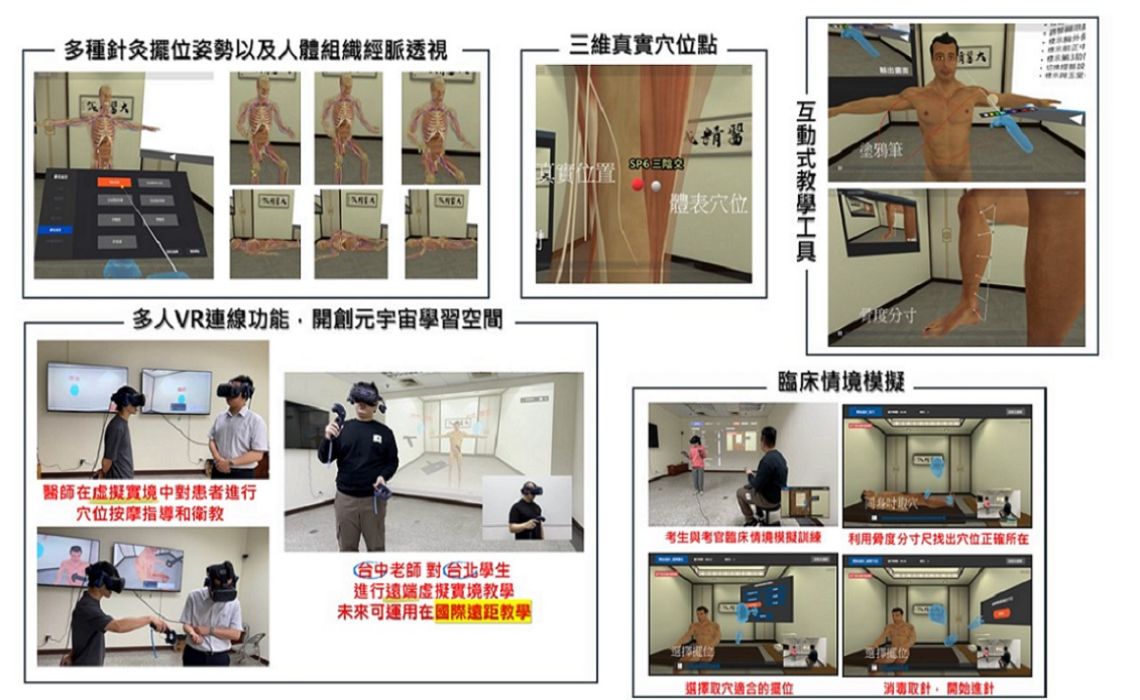
 AIoT智慧連網呼吸器脫離預測系統AIoT Intelligent Ventilator Weaning Prediction System彰化基督教醫院胸腔內科Chuanghua Christian Hospital, Department of Pulmonary Medicine黃國揚Kuo-Yang Huang發明人:許英麟、許家朗領域:智慧醫療、呼吸照護適應症:急性呼吸衰竭研發階段:跨院臨床驗證摘要:"AIoT智慧聯網呼吸器脫離預測系統" 旨在優化重症病患的呼吸器脫離過程,提升醫療品質並降低醫療成本。呼吸器脫離是重症醫療中的一項重要挑戰,傳統的臨床決策往往依賴經驗,存在較高的拔管失敗風險與併發症。為解決這些問題,我們開發了一個結合遷移式機器學習技術的智慧系統,能夠實時分析病患的呼吸參數,提供精確的拔管時機建議。這個系統已在多家醫院中實施,並且展現了顯著的成效,如呼吸器使用天數和住院時間的減少,拔管成功率的提升,以及醫療資源的優化利用。未來,我們計劃進行更大規模的臨床驗證,並推廣至國內外醫療機構,進一步提升全球醫療服務品質。
AIoT智慧連網呼吸器脫離預測系統AIoT Intelligent Ventilator Weaning Prediction System彰化基督教醫院胸腔內科Chuanghua Christian Hospital, Department of Pulmonary Medicine黃國揚Kuo-Yang Huang發明人:許英麟、許家朗領域:智慧醫療、呼吸照護適應症:急性呼吸衰竭研發階段:跨院臨床驗證摘要:"AIoT智慧聯網呼吸器脫離預測系統" 旨在優化重症病患的呼吸器脫離過程,提升醫療品質並降低醫療成本。呼吸器脫離是重症醫療中的一項重要挑戰,傳統的臨床決策往往依賴經驗,存在較高的拔管失敗風險與併發症。為解決這些問題,我們開發了一個結合遷移式機器學習技術的智慧系統,能夠實時分析病患的呼吸參數,提供精確的拔管時機建議。這個系統已在多家醫院中實施,並且展現了顯著的成效,如呼吸器使用天數和住院時間的減少,拔管成功率的提升,以及醫療資源的優化利用。未來,我們計劃進行更大規模的臨床驗證,並推廣至國內外醫療機構,進一步提升全球醫療服務品質。

 運用生成式AI及大型語言模型優化急診就醫治療流程:從醫病對話到治療建議Using Generative AI and Large Language Models to Optimize Emergency Medical Treatment Processes: From Doctor-Patient Dialogues to Treatment Recommendations臺北醫學大學大數據科技及管理研究所Taipei Medical University Graduate Institute of Data Science張詠淳Yung-Chun, Chang發明人:張詠淳、黃婷韵領域:急診醫學、大型語言模型、自然語言處理適應症:急診壅塞問題、高風險病患的即時處置、診斷錯誤風險的降低、非計劃性返診的預測與管理、臨床決策支援研發階段:本系統透過精確分析臨床結果與患者主訴,能有效預測病患72小時內進ICU的風險,提升急診醫師的決策能力並改善治療成果。結合電子病歷數據,預測急診病患的未來動向和非計劃性返診,緩解急診室擁擠並提高預後質量。利用大型語言模型處理醫療記錄,證實其在病歷描述準確性和完整性方面與人類相當,顯著縮短記錄時間,展示了技術在研發階段的改進潛力。摘要:國內醫院急診部門普遍面臨壅塞問題,導致病患等待床位時間延長或醫療照護時間被延誤,進而可能影響健康照護品質及病人安全,本團隊由急診醫學專家及人工智慧精準醫療研究團隊組成,具備豐富的臨床經驗與技術背景。 自2022年起,由雙和醫院急診醫學科主治醫師黃婷韵醫師與臺北醫學大學大數據科技及管理研究所張詠淳教授領軍,展開急診相關的AI臨床試驗研究,專注於利用自然語言處理和大型語言模型技術改善急診病患分類與處置流程。透過大量的臨床數據驗證,我們成功有效識別高風險病患,並提供即時的醫療處置建議。此系統在臨床應用中成效顯著,能縮短病人等待時間,降低診斷錯誤及延誤治療的風險,尤其是在高風險病患的處理上,提供精準及即時的醫療介入。本團隊研究核心技術包括:
運用生成式AI及大型語言模型優化急診就醫治療流程:從醫病對話到治療建議Using Generative AI and Large Language Models to Optimize Emergency Medical Treatment Processes: From Doctor-Patient Dialogues to Treatment Recommendations臺北醫學大學大數據科技及管理研究所Taipei Medical University Graduate Institute of Data Science張詠淳Yung-Chun, Chang發明人:張詠淳、黃婷韵領域:急診醫學、大型語言模型、自然語言處理適應症:急診壅塞問題、高風險病患的即時處置、診斷錯誤風險的降低、非計劃性返診的預測與管理、臨床決策支援研發階段:本系統透過精確分析臨床結果與患者主訴,能有效預測病患72小時內進ICU的風險,提升急診醫師的決策能力並改善治療成果。結合電子病歷數據,預測急診病患的未來動向和非計劃性返診,緩解急診室擁擠並提高預後質量。利用大型語言模型處理醫療記錄,證實其在病歷描述準確性和完整性方面與人類相當,顯著縮短記錄時間,展示了技術在研發階段的改進潛力。摘要:國內醫院急診部門普遍面臨壅塞問題,導致病患等待床位時間延長或醫療照護時間被延誤,進而可能影響健康照護品質及病人安全,本團隊由急診醫學專家及人工智慧精準醫療研究團隊組成,具備豐富的臨床經驗與技術背景。 自2022年起,由雙和醫院急診醫學科主治醫師黃婷韵醫師與臺北醫學大學大數據科技及管理研究所張詠淳教授領軍,展開急診相關的AI臨床試驗研究,專注於利用自然語言處理和大型語言模型技術改善急診病患分類與處置流程。透過大量的臨床數據驗證,我們成功有效識別高風險病患,並提供即時的醫療處置建議。此系統在臨床應用中成效顯著,能縮短病人等待時間,降低診斷錯誤及延誤治療的風險,尤其是在高風險病患的處理上,提供精準及即時的醫療介入。本團隊研究核心技術包括:
(1) 本系統能精確分析臨床結果與患者主訴的相關性,並有效預測病患在72小時內進入ICU的風險。這一功能大幅提升了急診醫師的決策能力,並改善了病患的治療成果。
(2) 通過結合電子病歷中的數據,本系統能夠預測急診病患的未來動向和72小時內的非計劃性返診,並在多個關鍵性能指標上表現卓越,有效緩解了急診室的擁擠問題,同時提高了病患的預後質量。
(3) 本技術融合了電子病歷中的文字和文本化數據,有效預測病患所需的醫療措施,從而提高醫療服務的時效性和精確性。
(4) 利用大型語言模型處理醫療記錄和文檔撰寫,並與初級住院醫師在客觀結構臨床考試(OSCE)中的表現相比較。結果顯示,大型語言模型在描述病歷的準確性和完整性方面達到了與人類相當的水平,顯著縮短了醫療人員記錄病歷的時間。
上述技術的研究成果已於2023年和2024年分別刊登於國際頂尖期刊《Journal of Biomedical Informatics》和《International Journal of Medical Informatics》,並已申請相關人工智慧專利。本團隊不斷進行技術研發與臨床測試,將開發的技術整合成一套完整流程,近年更針對大型語言模型與生程式技術持續優化產品,以確保系統在真實世界中的應用效果,期望能大幅提升急診醫療的效率與品質,為病患提供更優質的醫療照護。
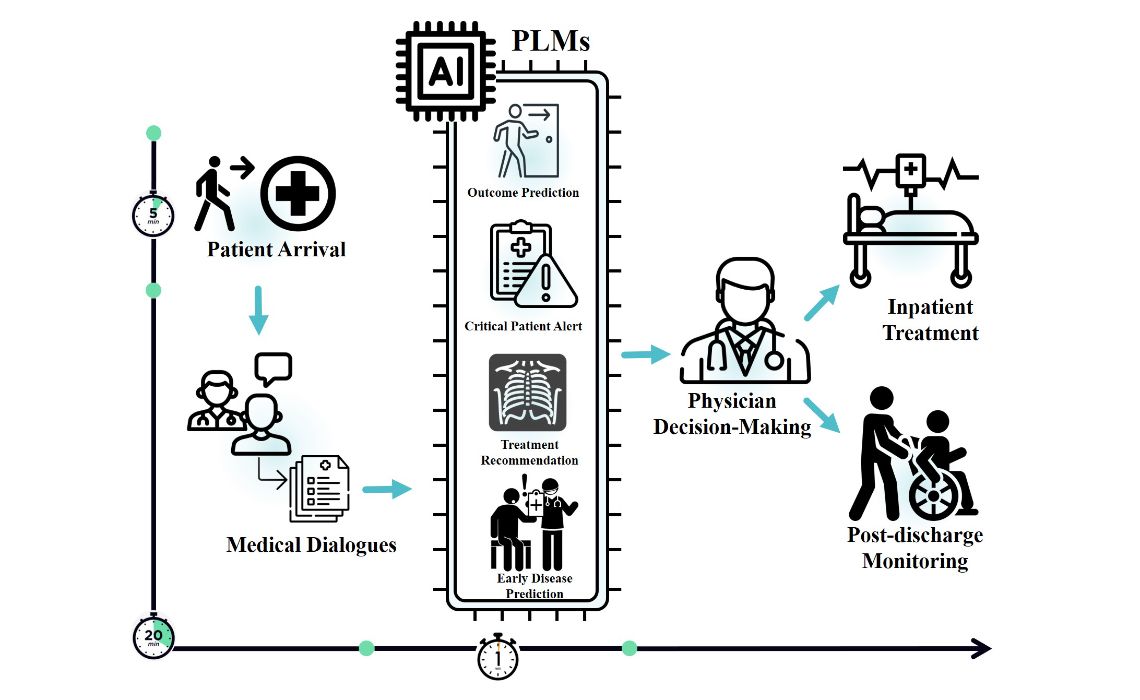
 益口拍-全口人工智慧 AI 口腔癌篩檢行動 AppTitle of Application: Artificial Intelligence Comprehensive Oral Cancer Screening Mobile App國立台灣大學醫學院附設醫院影像醫學部National Taiwan University Hospital, Department of Medical imaging陳世杰Shyh-Jye Chen發明人:陳世杰/Chen, Shyh-Jye 、李正喆/Lee, Jang-Jaer、周呈霙/Chou, Cheng-Ying、 黃裕城/Huang, Yu-Cheng、徐 郁/Hsu, Yu、李俊慶/Lee, Jun-Ching、陳信妤/Chen, Hsin-Yu、鍾子平/Zhong, Zi-Ping、林永隆/Lin, Yong-Long、劉宇捷/Liu, Yu-Chieh、廖俊凱 /Liao, Jun-Kai領域:癌症醫學適應症:口腔癌及癌前病變篩檢研發階段:已申請美國臨時專利摘要:益口拍利用人工智慧技術及普及的智慧手機 App 作為媒介進行全口的口腔癌篩檢,可在
益口拍-全口人工智慧 AI 口腔癌篩檢行動 AppTitle of Application: Artificial Intelligence Comprehensive Oral Cancer Screening Mobile App國立台灣大學醫學院附設醫院影像醫學部National Taiwan University Hospital, Department of Medical imaging陳世杰Shyh-Jye Chen發明人:陳世杰/Chen, Shyh-Jye 、李正喆/Lee, Jang-Jaer、周呈霙/Chou, Cheng-Ying、 黃裕城/Huang, Yu-Cheng、徐 郁/Hsu, Yu、李俊慶/Lee, Jun-Ching、陳信妤/Chen, Hsin-Yu、鍾子平/Zhong, Zi-Ping、林永隆/Lin, Yong-Long、劉宇捷/Liu, Yu-Chieh、廖俊凱 /Liao, Jun-Kai領域:癌症醫學適應症:口腔癌及癌前病變篩檢研發階段:已申請美國臨時專利摘要:益口拍利用人工智慧技術及普及的智慧手機 App 作為媒介進行全口的口腔癌篩檢,可在
偏鄉及醫療資源缺乏,及專科醫師可近性差的地方,增加口腔癌篩檢普及度以及病人警
覺,填補口腔癌篩檢的缺口。
本APP包含具有互動式功能的口腔攝影導引,以實現全口口腔的攝影和評估。使用者操作該系統時,可獲得軟體部件提供的引導,這些引導可協助用戶捕捉完整口腔黏膜的影像,系統將蒐集到的口腔影像進行前處理,然後這些影像將進入具有先進神經網路和影像處理功能的軟體模組,用於進行口腔證以及癌前病灶的偵測、分類和分析。目前對於口腔黏膜病灶正確辨識率都可以穩定到九成以上。 同時,系統還可以根據偵測和分類的結果,向用戶提供相關的健康建議和衛教內容,於介面上呈現於用戶可接收之位置,以幫助用戶更好地瞭解自己的口腔健康狀況,並採取適當的預防和治療措施。
